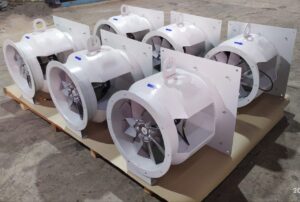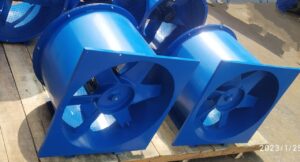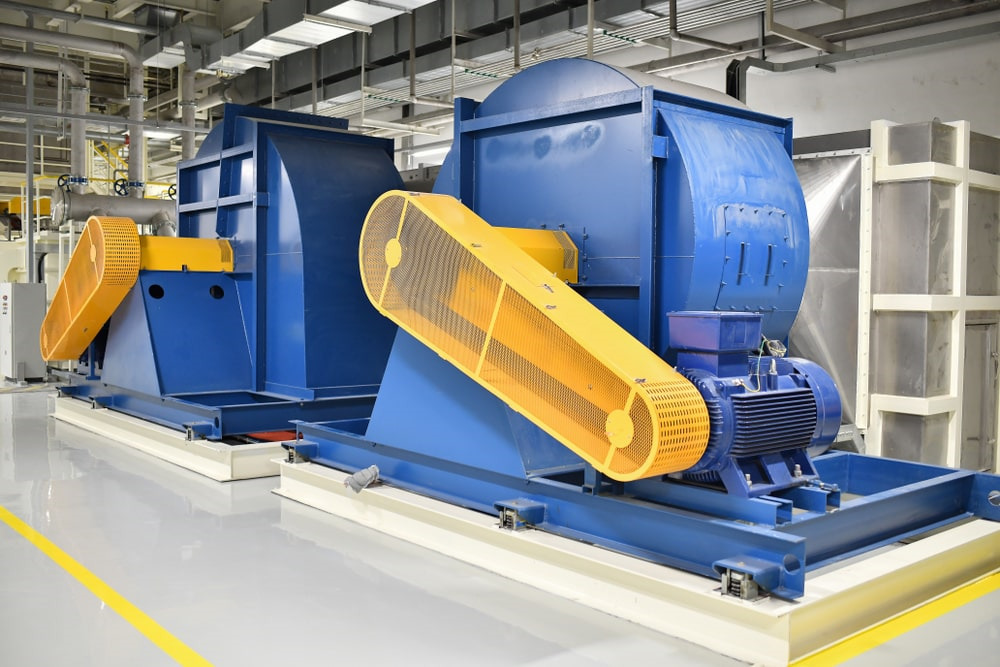Fans are essential in many industries for a variety of applications, including ventilation, cooling, and heating. Two common types of fans used in many applications are axial fans and centrifugal fans. Both fans serve a similar purpose, but they have significant differences in their design, performance, and efficiency. This article aims to explore the key points between axial fans vs centrifugal fans and their respective efficiencies.
Axial Fans vs Centrifugal Fans: Understanding the Differences

Axial fans and centrifugal fans differ in the way they move air. Axial fans work by generating a flow of air parallel to the axis of rotation. This type of fan moves air through the use of blades that push the air in a straight line, similar to a propeller. Axial fans are typically used in applications where a large volume of air needs to be moved at a low pressure, such as cooling electronic equipment or ventilation systems.
Centrifugal fans, on the other hand, work by generating a flow of air perpendicular to the axis of rotation. This type of fan moves air through the use of blades that spin around a central hub. The spinning blades create a centrifugal force that propels air outward, perpendicular to the axis of rotation. Centrifugal fans are typically used in applications where a moderate-to-high pressure is required, such as in air conditioning systems, furnaces, and industrial ventilation systems.
Centrifugal Fan vs Axial Fan Efficiency

The efficiency of a fan is determined by its ability to move air while consuming the least amount of energy. The efficiency of an axial fan is affected by several factors, including blade shape, blade angle, and the number of blades. Axial fans tend to have a lower efficiency than centrifugal fans because they have lower static pressure capabilities.
Centrifugal fans have higher efficiency than axial fans because they can generate higher static pressures. The efficiency of a centrifugal fan is affected by several factors, including the impeller size, blade shape, blade angle, and the number of blades. Centrifugal fans are more efficient at higher pressures and can maintain a high flow rate at high static pressures.
How do Axial Fans Work?
Axial fans consist of a central hub and several blades that extend radially from the hub. The blades are shaped like an aeroplane wing and angled slightly to generate a forward thrust. When the fan rotates, the blades generate a flow of air that moves parallel to the axis of rotation. Axial fans can be designed to have a variety of blade shapes and angles to suit different applications.
Which is Better: Centrifugal Fan or Axial Fan?

Choosing the right dust collector fan for a specific application depends on several factors, including the required flow rate, the required pressure, and the energy consumption. Axial fans are more suitable for applications where a large volume of air needs to be moved at low pressure. Examples of such applications include cooling electronic equipment and ventilation systems. Centrifugal fans are more suitable for applications where moderate-to-high pressure is required. Examples of such applications include air conditioning systems, furnaces, and industrial ventilation systems.
Centrifugal Fans vs Axial Fans: Which is More Efficient?
If we talk about the axial fan vs centrifugal fan efficiency, Centrifugal fans are generally more efficient than axial fans, but this is not always the case. The efficiency of a fan depends on several factors, including the fan’s design, size, and operating conditions. Generally, centrifugal fans supplied by Atmax are more efficient at higher pressures and can maintain a high flow rate at high static pressures. Axial fans, on the other hand, are more efficient at lower pressures.
Difference between Axial Fans and Centrifugal Fans

Airflow direction: Axial fans generate a flow of air parallel to the axis of rotation, while centrifugal fans generate a flow of air perpendicular to the axis of rotation.
Blade design: Axial fans have blades that push air in a straight line, similar to a propeller, while centrifugal fans have blades that spin around a central hub and create a centrifugal force that propels air outward.
Pressure capabilities: Axial fans are better suited for moving a large volume of air at low pressure, while centrifugal fans can handle moderate-to-high pressure applications.
Efficiency: Centrifugal fans are generally more efficient than axial fans, particularly at higher pressures.
Application: Axial fans are typically used for cooling electronic equipment or ventilation systems, while centrifugal fans are commonly used in air conditioning systems, furnaces, and industrial ventilation systems.
Advantages of Axial Fans
High airflow rate: Axial fans can move large volumes of air with low power consumption, making them ideal for applications where high airflow rates are required.
Simple design: Axial fans have a simple design with fewer parts, making them easier to install, operate and maintain.
Low noise: Axial fans produce less noise compared to other fan types, making them suitable for applications where noise is a concern.
Low cost: Axial fans are generally less expensive compared to other fan types, making them a cost-effective option.
Disadvantages of Axial Fans
Limited static pressure: Axial fans have limited static pressure capabilities and are not suitable for applications that require high pressure.
Inefficient at high pressure: Axial fans are less efficient at higher pressures, which can lead to increased energy consumption.
Limited direction of airflow: Axial fans can only move air in one direction, limiting their flexibility in certain applications.
Large size: Axial fans can be quite large, making them difficult to install in compact spaces.
Advantages of Centrifugal Fans
High pressure capabilities: Centrifugal fans can generate higher static pressures than axial fans, making them ideal for applications that require high pressure.
Efficient at high pressure: Centrifugal fans are more efficient at higher pressures, leading to lower energy consumption.
Versatile: Centrifugal fans can be used in a variety of applications due to their ability to generate high pressure and high airflow rates.
Directional flexibility: Centrifugal fans can move air in different directions, making them suitable for applications where airflow needs to be directed in specific directions.
Disadvantages of Centrifugal fans
Higher noise: Centrifugal fans can produce more noise compared to other fan types, which can be a concern in some applications.
Complex design: Centrifugal fans have a more complex design with more parts, making them more challenging to install, operate and maintain.
Higher cost: Centrifugal fans are generally more expensive than axial fans due to their higher pressure capabilities and more complex design.
Lower airflow rate: Centrifugal fans can move less air compared to axial fans, making them less suitable for applications that require high airflow rates.
Conclusion
Overall, while both fans serve a similar purpose, their differences in design and performance make them more suitable for different applications. It’s important to consider the specific needs of a given application when choosing between axial fans and centrifugal fans to ensure the most efficient and effective solution is selected.

